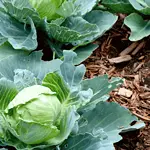Some people think they cannot garden because they live in nontraditional gardening spaces like apartments or places with low light but with microgreen gardening trays, the gardening comes to you!
The benefits of growing microgreens are that they can be grown all year anywhere you live. The reason is that they can be easily grown indoors or in greenhouses. With the right temperatures, airflow, light, and supplies you are set for success.
As you start growing microgreens, selecting the right trays can be a challenge as there are so many options and many of them look the same. What should you look for? Do I need one with holes or without, or even both, what are the advantages, and how deep should it be, with a transparent cover or blackout dome?

Growing microgreens using trays is more convenient than ever! This list below of the best microgreen trays puts together the absolute best microgreen trays on the market so you can grow the best greens you have ever eaten – right from inside the comfort of your home
We’re going to discuss everything that you need to know about microgreen trays. This will help you decide what tray you may go for, as we present our top ones on the market.!
Recommended Microgreen Trays on The Market
Urban Farm Supply – Extra Strength Microgreens Seedling Trays
- STACKABLE & REUSABLE NEW DESIGN – Excellent quality, extremely durable and made for repeat use, lasting 6 – 8 years. Say goodbye to weak, single-season 1020 plant trays and hello to an industrial strength, weather resistant microgreen and propagation tray! Made from food safe, BPA free, non-leaching PP polypropylene #5 plastic.
LeJoy Garden – Seed Sprouter Tray
- No soil is needed, only water, you can also taste fresh vegetables grown by yourself at home.
- Concave-convex design can easily take out the white tray, the white tray has strong air permeability, is conducive to seed germination.The aperture is dense,so the small
Living Whole Foods – Plant Growing Trays
- Durable Plastic – No Drain Holes
- Perfect for hydroponic growing and seed starting
- 21″ by 11″ (top measurement). 20″ by 10″ bottom of tray.
- Accomodates 20″ x 10″ Sure to Grow Hydroponic Grow Pads Perfectly
- Reusable
Bootstrap Farmer – Extra Strength Seedling Trays
- Ultra-Durable, Top-Quality BPA Free Plastic Trays No Holes. Will last you many years
- Perfect match to our heavy duty 1020 Trays. Outer Dimension: 10.75″ x 10.5″ x 2.375″
- 1 Year Warranty guaranteed not to break so you can focus on growing and not replacing equipment
- Made of recyclable Polypropylene (PP #5) leach resistant plastic with no harmful additives
- Perfect plant germination tray for heat mats, humidity domes, microgreens, wheatgrass, fodder, hydro
Bootstrap Farmer – 5×5 Seed Tray
- Ultra-Durable, Top-Quality BPA Free Plastic Trays with drainage slits. Will last multiple seasons
- Get organized or show off your microgreen display with vibrant colors to showcase your product
- 8 of the 5×5 inserts fit perfectly in our 1020 Heavy Duty Flats
- Also makes a great pairing with our multi-colored microgreen trays
- Our seedling trays are NOT flimsy. Keep growing without worrying about replacing your equipment
King Creek Farms – 1020 Plant Trays
- They are extra heavy-duty with a thickness of 2,3 mm. They are built to withstand heavyweight. They fit most domes and cell plug trays and can be stacked for storing.
Bootstrap Farmer – Microgreen Tray Grower with Humidity Domes
- Ultra-Durable, High-Quality, 32 Cell Starter Tray Kit w/ Flat and Dome. Made for many seasons
- Domes and Trays are NOT flimsy or brittle. Won’t crack or break while handling unlike competitors
- Heavy Duty Humidity Dome 5″ height (4.5″ interior space). Built in vents for controlled airflow
- Cell is 2″ square by 2″ deep. Outer Dimensions: 21.25″ x 11.25″ germination tray
- Gift set Kit to get start growing seedlings. BPA Free Plastic Seed Starter Kits.
- Material-Pack of 10 Black Plant Propigation trays without drain holes ,Durable Food safe BPA Free Polypropylene
- Multifunctional use -Perfect fit for sure to Grow Hydroponic , Growing trays can hold heavy loads without warping or breaking
- Dimension -21.2” x 11” x 2.4”, big and strong enough to plant seed tray. Easier to carry and more manageable.
- Reusable growing tray-Reusable plant growing tray for hydroponics, indoor gardening or in your greenhouse. Can also be used as as Wheatgrass trays, Microgreen trays, Fodder.
- Easy storage -The flat tray is a bit wider on the top and slightly tapers to the bottom to make the trays stackable for easy storage.
Yield Lab – Propagation Tray
Microgreen Pros – Wooden Microgreen Tray
- WOODEN PLANTER TRAYS that you can display on your kitchen counters or as table centerpieces to show off your Microgreens, Wheatgrass, Succulents or Fairy Gardens.
- ATTRACTIVE WOODEN TRAYS THAT LOOK STUNNING in any decor. No need for those ugly plastic or acrylic growing trays to clutter your space 🙂 EACH PLANTER TRAY measures a convenient 15.75″ x 8″ and is 3.5″ tall with thick 3/4″ sides so that it can even fit on window ledges!
- EACH WOODEN MICROGREENS TRAY comes complete with an invisible reusable BPA FREE plastic waterproof liner and spray bottle for your convenience so you can reuse the tray time and time again. The see through liner allows you to life the plants up and check whether you are giving the correct amount of water.
Sheing Seed Sprouter Tray
- HEALTHY & DURABLE – SHEING seed germination tray made from BPA-free PP Material. Sprouting without soil or chemical additives. Enjoy healthy sprouts for salads, sandwiches, and soups.
- WIDE APPLICATION – This nursery tray can sprout multiple types of small seeds: Buckwheat, Okra, String bean, Peanut, Radish, and Grey pea.
- [360° rotating watering]:The bean sprouts machine automatically sprinkles water every 10 minutes for 1 minute, evenly spraying, and improves the germination rate of seeds.
- [8-hour memory function]: restore power within 8 hours after power off, the sprouts growing machine can continue to work automatically without resetting time.
- [Health and safety]: The sprouts growing kit is made of food-grade PP material and is easy to clean. Water and electricity separation design, don’t worry about electric shock, rest assured to use.
- [Double pressure tray design]: There is no separation between the germination trays of the sprouting kit, so that the bean sprouts grow thicker and the double-layer planting yields more.
Growneer Growing Trays
- WHAT YOU GET — 3 packs of bonsai training pots with 3 pcs trays, comes with 15 pcs plant labels, providing convenient for you to identify your plants by marking their name on the labels.
- SIZE — Pot: length 11.4”, width 8.5”; tray: length 10.5”, width 7.4”; the total height: 4.2”, including planter and tray. The bonsai training pot is suitable for planting succulents, cactus, bonsai plants, etc.
- HIGH QUALITY — The plant pot is made of premium plastic, which is durable, eco-friendly and allows you to reuse it for several seasons. The attached tray can store water drained out of the pot to keep your area clean.
 Green Fingers Plant Growing Tray
Green Fingers Plant Growing Tray
- Keep an eye on your growth: The only design in the market- High-quality clear plastic trays of this seed grow kit makes it easy to observe your plants without interrupting the process.
- Total control: Adjustable vents of this seed trays allow you to regulate the temperature and humidity of your seedling environment, so you have total control over the growing process
- Perfect size for seed starting: Size of the cells: 1.5”in Length and 1.5”in Wide, these seed trays are suitable for small seeds, such as flowers, vegetables, fruits, tobacco and other plants.
Eco Sprout Seed Tray
- HEAVY DUTY – Stop being frustrated with trays that bend and flex when moved; our trays won’t bend when moved; able to withstand weight at optimum capacity (we stopped testing at 50 lbs, some competition failed at 5 lbs!)
- DESIGNED FOR SUCCESS – Trough & ridge design provides separation for maximum water retention; Will accommodate 8 Inch dome for optimum growing conditions; Versatile – Perfect for use as hydroponic growing, seed starting, seedlings, wheatgrass, microgreens and more (NO Drain Holes)
- REUSABLE – Our reusable trays are an eco-friendly investment to cut costs & reduce waste
- FOOD SAFE – Feel confident growing food-safe vegetation – our trays are BPA free
What Type of Trays Do I Need for Growing Microgreens?
Purchasing the wrong microgreen tray can be majorly problematic because of only one wrong mistake and your gardening experience can go from fun and relaxing to a total burden!
If you accidentally buy the wrong depth, you might find yourself pulling clumps of dirt from your tub when it comes harvest time instead of simply snipping along your tray’s edge.
You can use several different types of trays to grow microgreens. The trays come in a variety of shapes and sizes. Your choice really depends on the size of the crops you want to grow, how you are going to grow, where you are going to store them, the aesthetics, and last but not least, your budget.
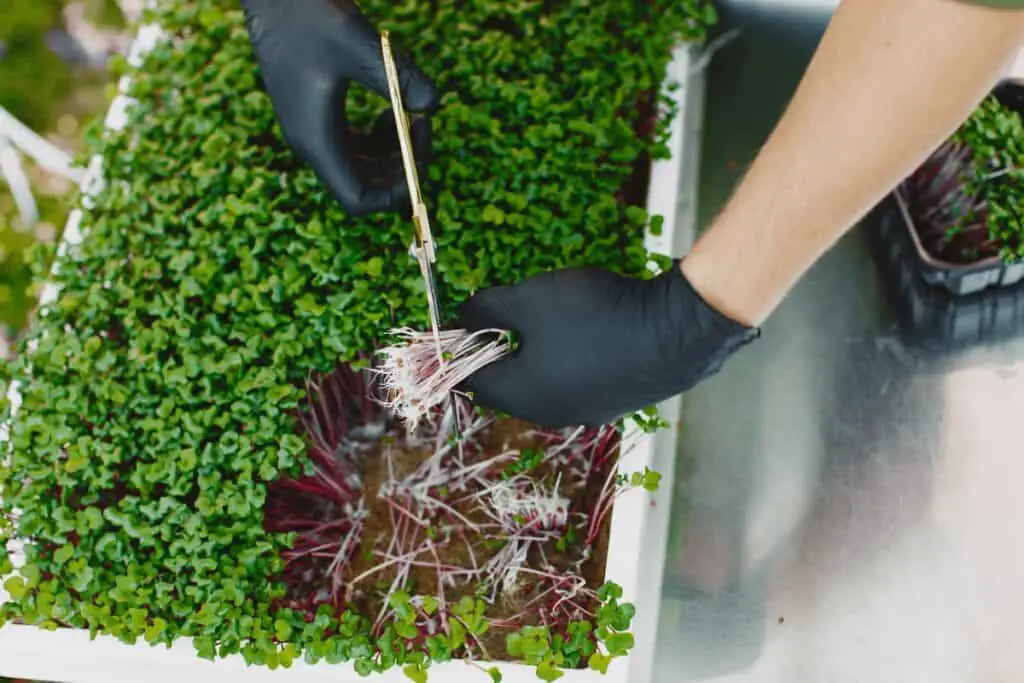
you want a tray that is durable and sturdy, especially if you’re going to be moving the tray around. We’d recommend staying away from flimsy trays. They may be cheaper, but they will not last you as long. You’ll see them break or warp too easily.
You also don’t need anything too deep. Microgreens can grow in very shallow trays. When I say shallow, I’m talking about between one and two inches.
That’s all you need. The shallower your tray is, the less soil you waste, and the easier it will be for you to cut when ready to harvest.
Do Microgreen Trays Need Drainage Holes?
Well, that depends. You’ll notice that some of the best microgreen trays have holes in the bottom, and others don’t. So which one is better? The truth is neither of them is better than the other. They serve different purposes and can both be useful to grow microgreens.
You can use both trays with holes and trays without holes. The deciding factor is how you plan to grow your microgreens.
Even though microgreen trays don’t necessarily require holes, they are still a good idea in many cases.
You don’t need to invest in a tray with holes, but they can be useful for watering your crops from underneath. Holes in the bottom of a tray can allow water to be wicked from a tray underneath, eliminating the need for overhead watering of the microgreens.
You place your seeds in a tray with holes and place it inside of a hole-less tray that has water in it. This way of watering gives good control and easier to overcome the issue of excessive watering.
Another thing you can do with a tray without holes is to flip it over and use it on top of another tray (with or without holes) as a humidity and blackout dome.
When using a tray without holes, you have to water the microgreens from the top, using a spray bottle to moisten the soil. It’s important you don’t over-water your microgreens, to avoid any water buildup in the bottoms of the trays.
Do I Need a Deep Tray?
Regardless of the medium, you will use, another factor to consider is the depth of the tray. They come in different sizes and depths. When growing microgreens the tray doesn’t need to be deep.
You may want to look for trays that have a depth allowing for about 1.5 inches of growing medium. The reason is that the seedlings will not need a lot of root space since they will only grow to about 1-2 inches in height.
If you are growing in soil, using a shallow tray may cause your tray to drop and you can’t add more soil than 1.5 inches. If you are planning to harvest for commercial scale, then this may slow down your growing, but if you are growing a few trays for yourself it is enough with a 2 inches tray.
When it comes to depth, another important factor is that when you harvest your microgreens and the tray is high, you may have to take out the growing mat to cut close to the growing medium. Alternatively, you will cut higher up than what you normally would and lose nutritious stems.
How Many Seeds Do I Need for Each Tray?
Every crop is different which is why the number of seeds will vary but usually, small seeds require half the amount large seeds do. In general, most small seeds will only need around ¼ cup of seeds per 10 x 20 tray and large seeds need ½ cup per 10 x 20!
Since microgreen growing requires complete coverage, it is much more efficient to use a measuring cup (or similar measuring tool) to measure the number of seeds for your mini garden and sprinkle them across generously.
Do I Need to Cover My Microgreen Trays?
To speed germination, cover the pots with plastic wrap or a plastic dome that fits over the seed-starting tray. This helps keep the seeds moist before they germinate. When you see the first signs of green, remove the cover
You can, but you don’t have to. The benefit of covering them with another tray flipped upside down is it gives your microgreens a blackout period.
If you are growing larger, you can stack the trays on top of each other and use the other tray as a cover to get the darkness.
There are different options to cover your microgreens. You can, for example, use paper towels, domed lids, or white plastic trays.
If you don’t use the blackout lids, then you will have to put your microgreens in a place where you can give them the darkness they require for germination.
How Big Is a Tray for Microgreens?
The standard size tray is 10” x 20”. This is typically the size tray you want to look for since it will give you the most yield and is the most uniform among the microgreen growing community. If you are a beginner, you will grow accustomed to these measurements soon enough.
Furthermore, the depth of your tray can help determine how convenient this tray will be for you to harvest from. Generally, it is easier to harvest microgreens from shallow trays because you can see the division between your soil and roots more clearly.
Additionally, shallow trays tend to take up less space. That means, less space to fill with soil which costs less money, and less room on your shelves or gardening area! The more room you have, the more greens you can grow!
FAQ
There’s a reason that the vast majority of microgreens growers choose to use soil. It produces the best product, the highest yields, and tends to be the easiest to work for. But you could also consider coconut coir, vermiculite, hydroponics, or other growing mediums depending on your specific situation.
Sunflower. Sunflower microgreens are the most popular microgreens. They are rich in protein and vitamin B and add a slightly sweet taste to any dish. For the strongest flavor and healthiest plants, use seeds from the black oil variety.
Microgreens grow in very shallow trays, about one to two inches deep. Microgreens do not need a lot of space to grow their roots. Shallow trays need only a small amount of soil. Shallow trays also make harvesting microgreens easier and quicker.
There’s a reason that the vast majority of microgreens growers choose to use soil. It produces the best product, the highest yields, and tends to be the easiest to work for. But you could also consider coconut coir, vermiculite, hydroponics, or other growing mediums depending on your specific situation.
So do microgreen trays need holes? Microgreen trays with a soil-based medium don’t need holes for drainage because the root systems of microgreens are so shallow. Microgreens also typically grow too fast to become waterlogged. However, holes in microgreen trays can be useful for watering the tray from underneath.
Since microgreens have shallow roots, your container only needs to be a few inches deep and doesn’t have to have drainage holes, (although drainage does help – more this later in the post).
Basically, cut a piece of plywood to the size of your seeding flats. Then affixed little corks to one side. But be sure the corks are lined up to create holes spaced for the plants you plan to seed. In fact, you could make a few of these with corks spaced appropriately for a variety of seeds.
Ideally, you want very durable trays for growing microgreens. Durable microgreen trays make harvesting your microgreens a breeze and guarantee consistent watering for all your crops!
A durable tray will withstand transportation and can hold up against multiple uses. Cheap, flimsy trays sag over time which leads to uneven watering. Durable trays are built to last with plastic that resists warping especially when placed in direct sunlight!
Since your microgreens need moisture to thrive, the ideal tray should have good moisture retention. This means there are no drainage holes at the bottom, the bottom of the tray is even and does not collect at the corners, sides, or middles, and if possible, your tray offers a lid attachment that can help manage the humidity levels of your greens!
But you don’t need special equipment to grow microgreens – you can make your own plastic tray with a Tupperware box or plastic carton. Line the bottom with a layer of kitchen roll and make it moist but not wet. Sprinkle the seeds over the surface and keep moist as above
Conclusion
Finding the best trays to grow microgreens can be daunting as there are so many options out there. We hope that our list of top trays on the markets has been able to give you a good overview and will aid you to find your best choice.
Latest Posts
- How to Plant Lettuce Seeds for Maximum Germination

- How to Plant Kale Seeds: A Step-by-Step Guide to Maximum Germination Success!

- How to Plant Eggplant Seeds: A Step-by-Step Guide to Maximum Germination Success!
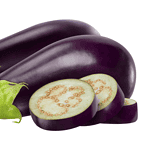
- How to Plant Cucumber Seeds for Maximum Germination
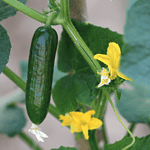
- How to Plant Chili Pepper Seeds for Maximum Germination
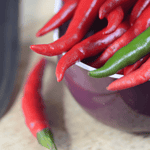
- How to Plant Cabbage Seeds for Maximum Germination
